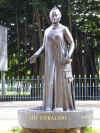Hawaii State Capitol
| "In addition to its beauty and efficiency, the building is an exercise in architectural imagery which is fascinating to discover, easy to bypass. No other state, of course, has the
irresistibly rich heritage of a monarchy to draw on, however paradoxically, to decorate a building which houses the workings of democracy."...
Aloha Magazine
March/April 1979
|
Symbolism of the architecture
The building is designed to resemble a volcano, specifically Punchbowl on O`ahu, which is within sight of the capitol. It is totally surrounded by a
reflecting pond, representing our islands in the Pacific Ocean. The 40 pillars supporting the roof are
coconut palms, which were a major source of food, water, building materials and other necessities, perhaps the most useful tree in the world. The support pillars on the top floor are grouped in eights, to represent the eight Hawaiian islands:
Hawai`i, Kaho`olawe,
Kaua`i, Lana`i, Moloka`i,
Ni`ihau, O`ahu, and Maui. In other parts of the building, groups of four represent the four
counties: Hawai`i, Kaua`i, O`ahu and Maui.
 Entrances
to the building are on the mauka (towards the mountains) and makai
(towards the sea) sides of the building. Copies of the state
seal on large bronze discs hang above the entries. A statue of
Queen Liliuokalani is on the makai side, which faces `Iolani
Palace, and one of Father Damien is on the mauka side, which faces
Punchbowl. Entrances
to the building are on the mauka (towards the mountains) and makai
(towards the sea) sides of the building. Copies of the state
seal on large bronze discs hang above the entries. A statue of
Queen Liliuokalani is on the makai side, which faces `Iolani
Palace, and one of Father Damien is on the mauka side, which faces
Punchbowl.
 The
main courtyard is open to the sky, with a 'dome' meant to symbolize
openness and the throat of a volcano. In the center is a mosaic
titled "Aquarius", designed by Maui artist Tadashi Sato, made
up of 6 million tiny tiles imported from Italy. The mosaic depicts
the changing colors and patterns of the sea around Hawaii. The
main courtyard is open to the sky, with a 'dome' meant to symbolize
openness and the throat of a volcano. In the center is a mosaic
titled "Aquarius", designed by Maui artist Tadashi Sato, made
up of 6 million tiny tiles imported from Italy. The mosaic depicts
the changing colors and patterns of the sea around Hawaii.
The courtyard has been used for a public lying-in-state three times since 1969: John A. Burns, the second Governor of Hawaii from 1962-1974, Spark Matsunaga, U.S. Senator from 1977 to 1990, and Israel Kamakawiwo`ole, entertainer, songwriter and humanitarian, in 1997.
| The Capitol's airy, open style suits it ideally to the gentle Hawaiian climate. Here is a Capitol where the sun, rain, and tradewinds are free to enter. The great central court, open to the sun and rain, moon and stars, rises to the sky like the throat of one of the volcanoes that helped build this land.
Symbolism
of the Capitol
Office of the Governor
|
The stone cone-shaped walls on the Diamond Head and Ewa sides of the
capitol enclose the senate and house chambers, respectively.
Inside, the senate chamber is decorated in cool sea and sky colors and
has a chandelier sculpture of polished aluminum and chambered nautilus
shells, titled "Moon". The house of representatives is
decorated in earth tones, accented with a light sculpture of gold plated
copper and brass, titled "Sun". The carpeting in both
chambers represents the ocean floor and paneling is koa or other native
woods found in the tropical rain forests of Hawaii.
 The
top floor houses the offices of the Governor and Lt. Governor. The
middle floors contain offices for each of the legislators and their
staffs, plus hearing and conference rooms. The
top floor houses the offices of the Governor and Lt. Governor. The
middle floors contain offices for each of the legislators and their
staffs, plus hearing and conference rooms.
Across Beretania Street is the Governor's residence, Washington
Place, and the Armed Forces Memorial. Memorials to veterans of the
Korean and Vietnam wars are located on the capitol grounds on Richards
Street (Ewa side).
The capitol was completed in 1969 at a cost of $24,576,900, excluding
land. A $67 million renovation was completed in 1995. The
structure includes an underground parking facility that cost $3,000,000
to construct. |
The "Dome"













|